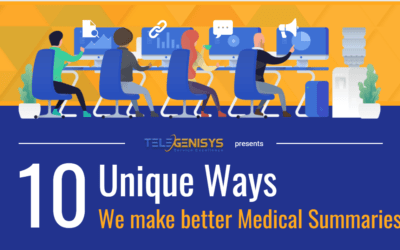De-Identifying Medical Records for Legal Use: Advanced Practices and Technology
Handling medical records securely and in compliance with legal standards is a critical task in healthcare and legal proceedings. As data becomes increasingly integral to decision-making, ensuring patient privacy through robust de-identification processes is essential, particularly when sharing records for legal work. This article delves into the importance, methods, and technologies for de-identifying medical records, with insights drawn from innovative practices.
Why De-Identification Matters
De-identification ensures that sensitive personal information is protected when patient records are used for legal, research, or operational purposes. This practice complies with privacy laws such as HIPAA (Health Insurance Portability and Accountability Act), which mandates the removal of Personally Identifiable Information (PII) and Protected Health Information (PHI) in specific contexts.
Key reasons for de-identifying medical records include:
- Legal Compliance: To meet HIPAA standards and other regulatory requirements.
- Patient Privacy: To ensure sensitive data, such as names and medical details, cannot be traced back to individuals.
- Data Utility: To enable the sharing of information for research, compliance reviews, or legal proceedings without risking privacy breaches.
The De-Identification Process
The de-identification process involves removing or obfuscating identifiable information from medical records. This includes:
- Removing Identifiers: Eliminate PII and PHI, such as names, dates of birth, addresses, social security numbers, phone numbers, and email addresses.
- Obfuscation: Replace sensitive data with dummy values to make it look realistic but unlinkable to the original individuals. For instance, replacing “John Smith” with “Jane Doe” and matching identifiers like zip codes to plausible regions.
- Retaining Structure: Keep the original structure of medical records intact to maintain their utility for research, training, and legal purposes.
Advanced Technologies for De-Identification
Modern de-identification at scale leverages cutting-edge technologies like cloud computing, machine learning, and natural language processing (NLP). Tools such as Spark NLP for Healthcare enable organizations to de-identify vast amounts of data efficiently.
Key Techniques:
- Named Entity Recognition (NER): Identifies and tags sensitive information, such as names and addresses, within text.
- Deep Learning Models: Trained on clinical data to handle the messy, unstructured nature of medical records.
- Obfuscation Pipelines: Automatically replace identifiers with contextually appropriate substitutes.
Example of Scale: Using tools like Spark NLP and Microsoft Azure, healthcare organizations can process hundreds of millions of patient notes. Advanced pipelines allow for scalable de-identification while maintaining data integrity, making this approach suitable for both day-to-day operations and large-scale historical data.
Legal Considerations, Public Records, and HIPAA Compliance
HIPAA provides two primary routes for de-identification:
- Safe Harbor: Requires removing 18 specific identifiers from structured data.
- Expert Determination: Employs statistical or scientific methods to ensure a very low risk of re-identification.
This is particularly necessary for unstructured data, such as patient notes.
In legal proceedings, de-identified medical records are often paired with public records such as court filings, subpoenas, or administrative reports. Public records, while accessible to the public under laws like the Freedom of Information Act (FOIA), may still contain sensitive data that could intersect with medical information. Proper de-identification ensures compliance with privacy laws while maintaining the integrity of the information required for legal analysis.
Moreover, in some states, like Georgia, it is important to exclude certain references during legal trials. For instance, collateral source information, such as the fact that a plaintiff has health insurance or that a defendant carries liability insurance, is not admissible in court. This includes removing all mentions of health or liability insurance in medical records when they are used in legal contexts. In Georgia, parties cannot benefit from the existence of health insurance during a trial, meaning that references to insurance must be carefully de-identified and excluded, except under rare circumstances. This practice ensures that the focus remains on the actual facts of the case rather than external financial factors.
Challenges in De-Identification
Despite technological advancements, de-identification remains complex:
- Data Complexity: Medical records often include free-text notes with inconsistent formatting, abbreviations, and errors.
- Residual Risks: Even advanced models can miss some identifiers, necessitating robust quality control.
- Equity and Fairness: Models must be tested for bias to ensure fair performance across diverse demographics.
The Future of De-Identification
As technology evolves, the de-identification process continues to improve:
- Fairness in AI: Ensuring de-identification tools perform equitably across all patient groups.
- Enhanced Validation: Using third-party adversarial testing to assess the robustness of de-identified datasets.
- Expanding Applications: Adapting de-identification techniques for other data types, such as imaging and genomic data.
Conclusion
De-identifying medical records is a crucial step in balancing patient privacy with the need for data-driven insights in legal and healthcare contexts. With modern tools and best practices, organizations can securely share information while adhering to legal and ethical standards
PROTECT PATIENT PRIVACY AND ENSURE LEGAL COMPLIANCE
Take action now to safeguard sensitive medical information and maintain legal compliance. Implement advanced de-identification practices in your organization to protect patient privacy while enabling critical data sharing for legal and research purposes. Contact our experts today to learn how our cutting-edge technologies can streamline your de-identification process, ensuring HIPAA compliance and data integrity. Don’t risk privacy breaches or legal complications – secure your medical records with state-of-the-art de-identification solutions.













0 Comments